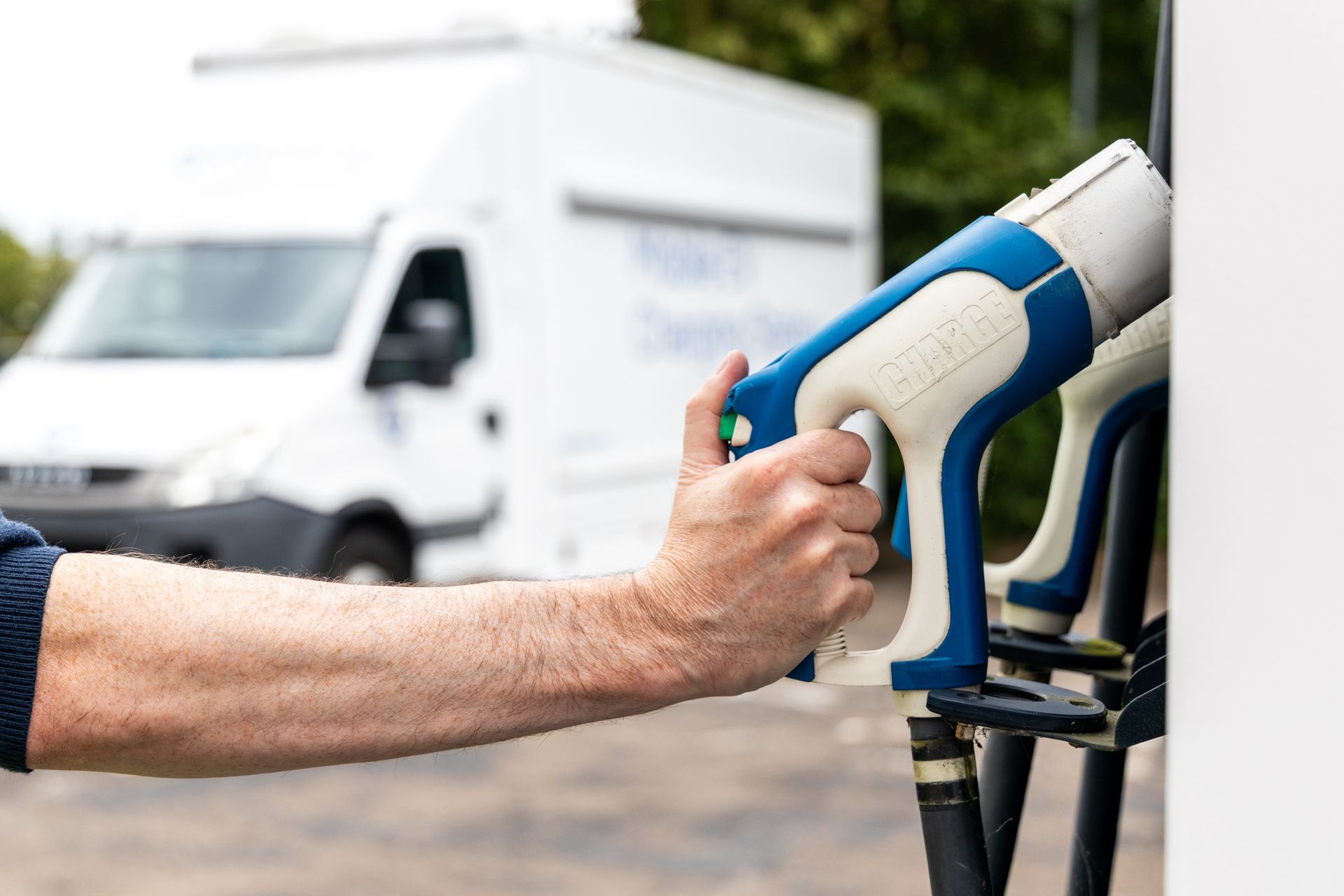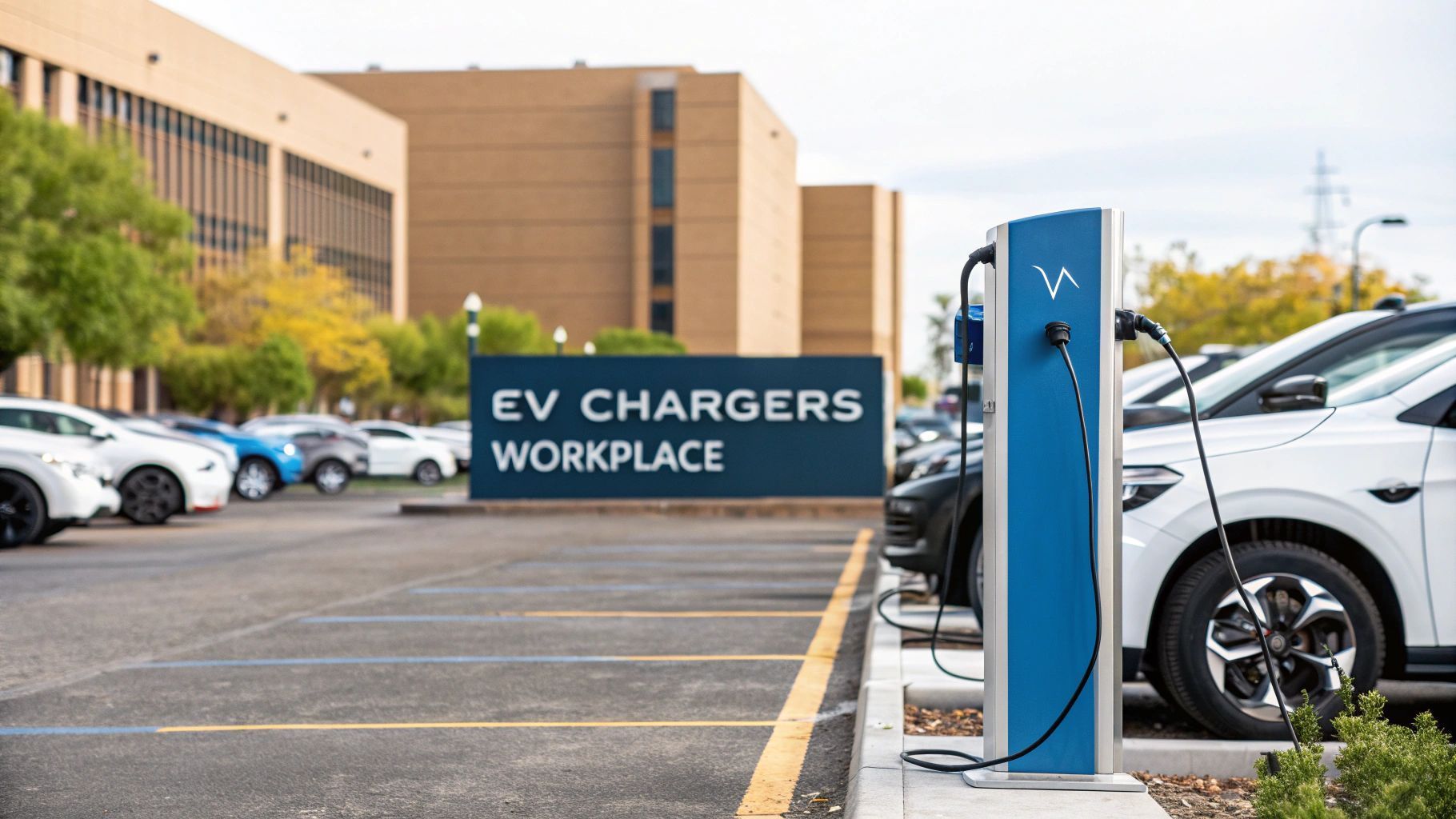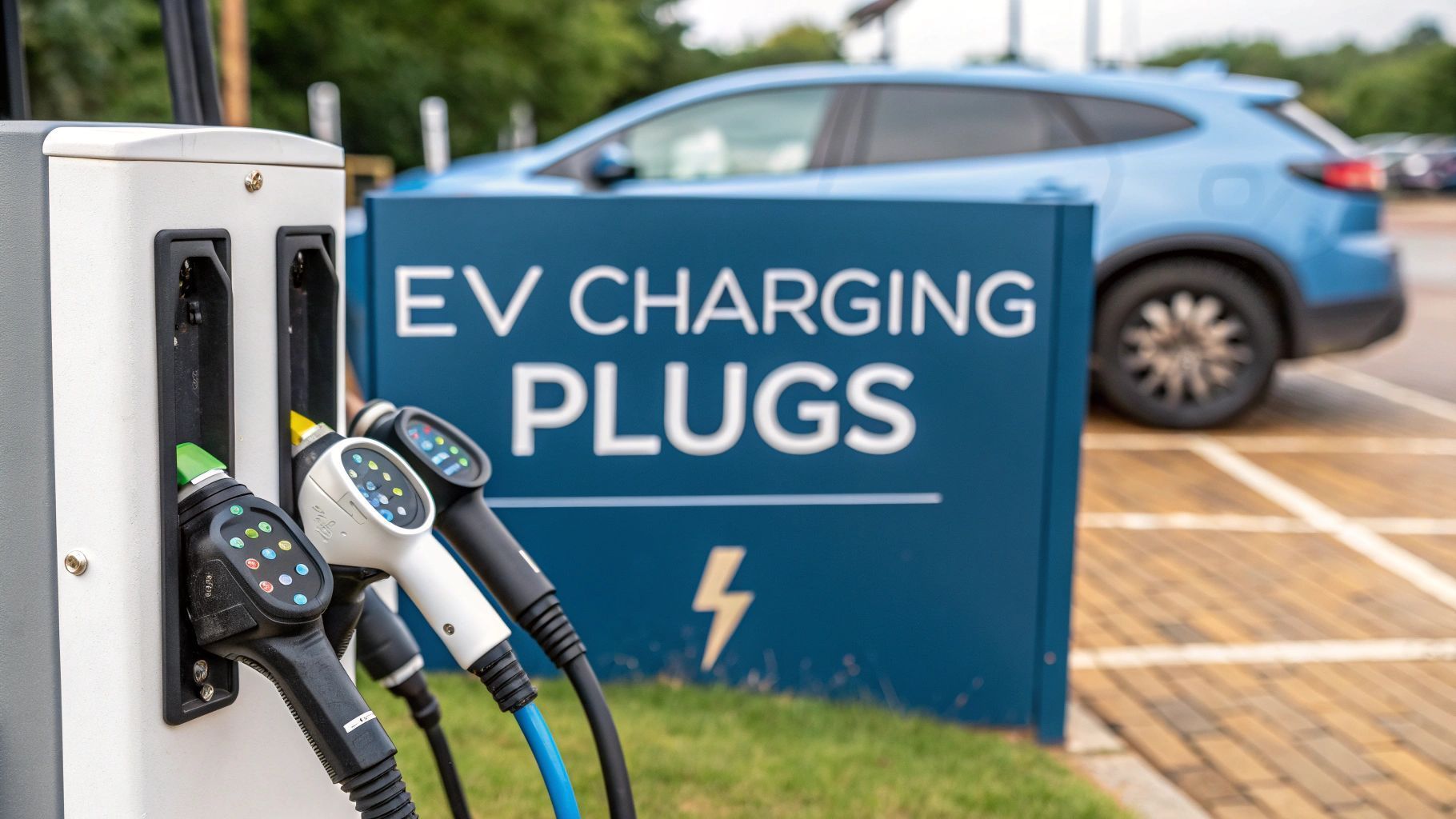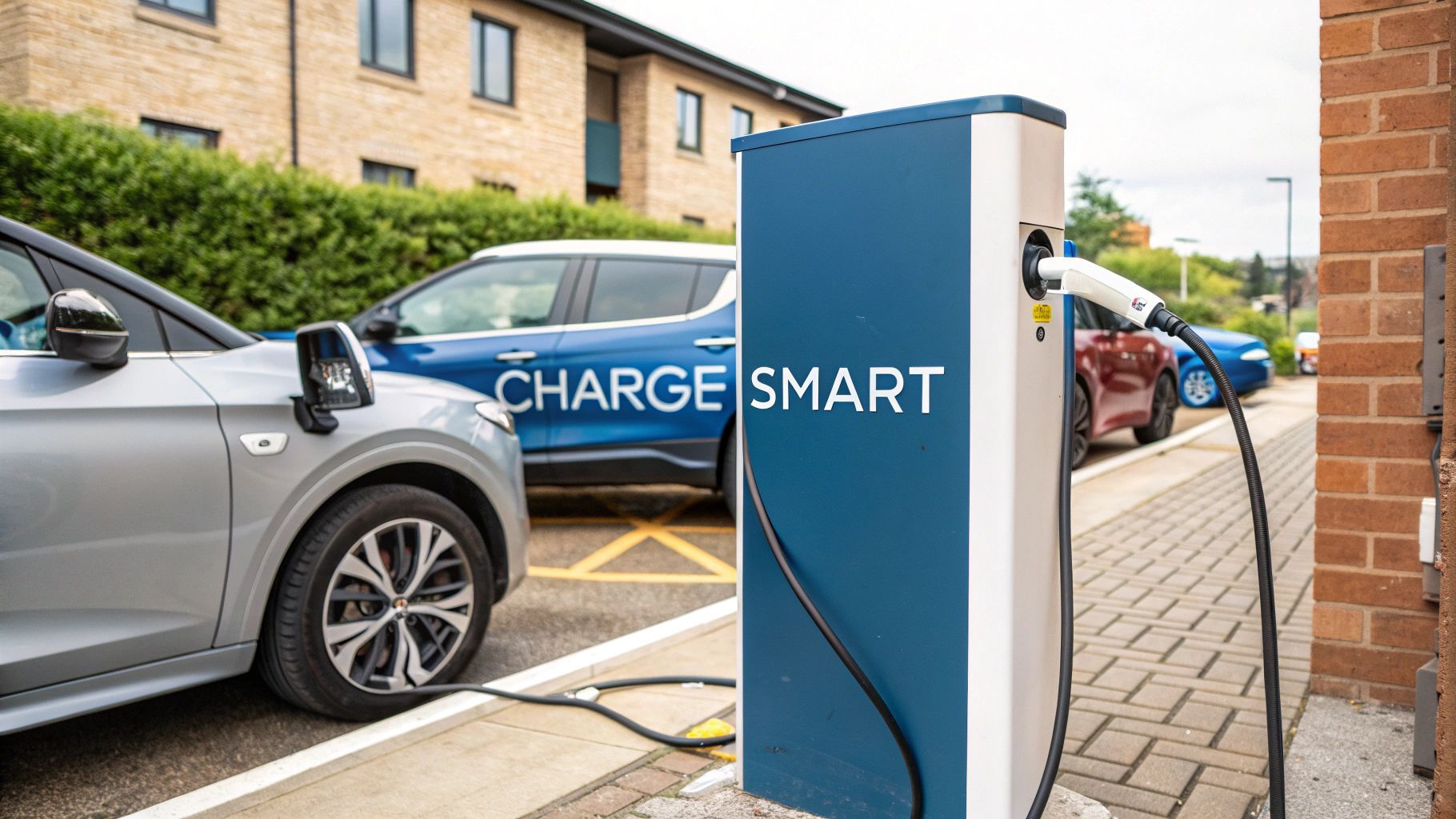Charging a Car Battery at Home UK Guide
Charging your car battery at home is easily the most convenient and affordable way to keep your electric vehicle topped up. For a tiny fraction of what you would pay at a public charger, you can wake up every morning to a full battery, ready for the day ahead. It is a simple overnight routine that saves money and completely removes the stress of hunting for an available charge point.
The Real Benefits of Home EV Charging
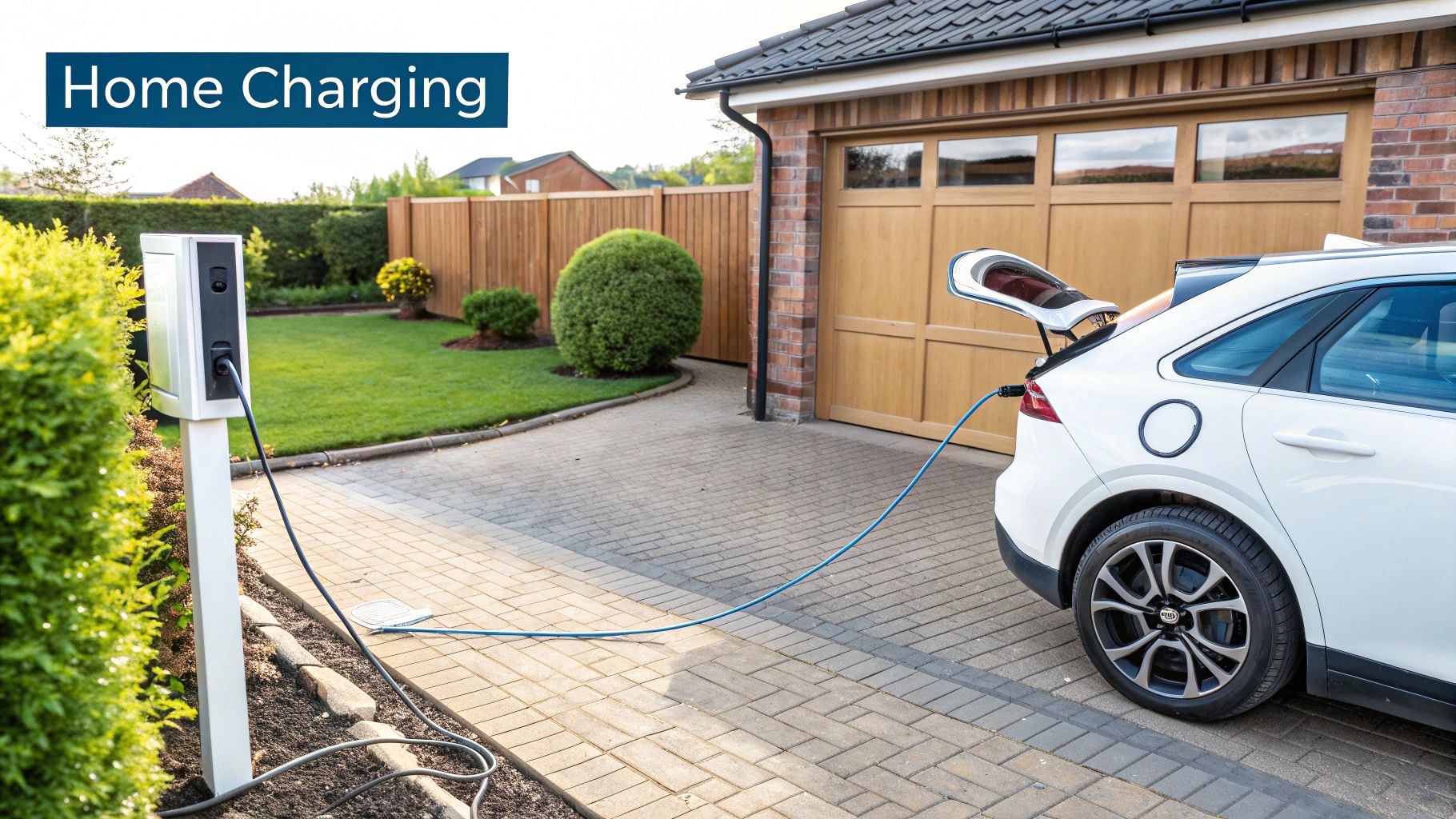
The shift to electric vehicles across the United Kingdom is happening fast and charging at home is the cornerstone of this change. It marks a real move away from the old model of filling up at a petrol station, towards a much more personal and integrated way of managing your energy.
Unbeatable Convenience and Cost Savings
Just imagine starting every day with a full "tank", completely eliminating range anxiety from your commute. That is the number one advantage of charging at home. You no longer have to plan your trips around public charging stops or waste time waiting in queues.
The financial side of things is just as persuasive.
The UK's EV fleet is growing at an incredible pace, with forecasts suggesting it could hit 7 million by 2030 . A huge driver behind this growth is the money you can save. Home charging allows drivers to save anywhere between £390 and £919 annually compared to those who rely only on public fast chargers. That is because nearly half of UK drivers find public options just too expensive.
For most EV owners, home charging is not just a perk; it becomes the default method. It transforms the vehicle from something you refuel elsewhere into an appliance you simply top up overnight, like a mobile phone.
Understanding Your Home Charging Options
When you start looking into charging a car battery at home, you will come across a couple of different setups. The most basic is a 3-pin plug charger, often called a 'trickle' charger. While it does not need any special installation, it is also painfully slow.
For a much faster and safer experience, a dedicated home charge point is the way to go. These units need to be professionally installed and typically come in 3.6kW or 7kW power ratings for most homes however ZPN offer the worlds first and only Rapid (level 3)Home EV charger . They are often "smart" chargers, which opens up a world of useful features:
- Scheduled Charging: You can set your car to charge during off-peak hours when electricity is cheapest.
- Energy Monitoring: It lets you track exactly how much electricity your car is using, helping you manage costs.
- Remote Control: You can start or stop a charging session right from your smartphone.
These features are central to enhancing the EV ownership experience and making everything more seamless. And for those who want to take their sustainability game to the next level, installing solar panels is a fantastic option to power your car with clean, free energy.
Choosing and Installing Your Home Charger
Getting the right kit for charging your EV at home is the first proper step towards making life easier. While there are a few options on the market, they really boil down to two types: slow ‘trickle’ chargers and faster, dedicated wall units. The one you pick will have a big impact on your charging speed and daily routine.
The most basic method is using a standard 3-pin plug, often called a ‘granny charger’. It is simple because it does not need a professional to install it, but my word, it is slow. For most modern EVs, you could be looking at a wait of over 24 hours for a full charge. This is not just impractical for daily use; it can also put a real strain on your home’s wiring over the long run.
For a solution you can actually rely on day in, day out, a dedicated home charger is the only way to go. These units are properly installed by an electrician and wired directly into your home's main supply, giving you much faster and safer charging.
Understanding Power Ratings and Smart Features
Dedicated home chargers come with different power ratings, measured in kilowatts (kW). Here in the UK, the most common setups are 3.6kW and 7kW . A 7kW charger is the sweet spot for most people, powerful enough to fully recharge a typical EV battery overnight. A 3.6kW unit will get the job done, but it will take a fair bit longer.
Some homes with a three-phase electrical supply can even handle a mighty 22kW charger, but that is not something you see every day in a residential setting. But thats only for normal run of the mill EV charger manufacturers, ZPN Energy as mentioned, offer Rapid at home charging via a battery and this can be run off your single phase connection. This means 50kW super fast charging. You should ask your installer for details!
Once you have settled on a power level, the next big decision is whether you want a ‘smart’ charger. I would always recommend one. These chargers connect to the internet, unlocking some brilliant features that give you more control and, crucially, save you money.
- Off-Peak Scheduling: You can set your charger to only top up your car during overnight hours when electricity tariffs are at their cheapest.
- Energy Tracking: A simple smartphone app lets you see exactly how much electricity your car is using.
- Remote Management: Start, stop, or pause a charging session from absolutely anywhere. It is incredibly handy.
To make sure your home's wiring can handle a new EV charger, you may need to look into professional electrical panel upgrade services. It is also vital to confirm your charger and vehicle are a good match. We have got more information on this in our guide to understanding EV charging compatibility.
The infographic below shows what a typical professional installation of a dedicated wall-mounted charger looks like.
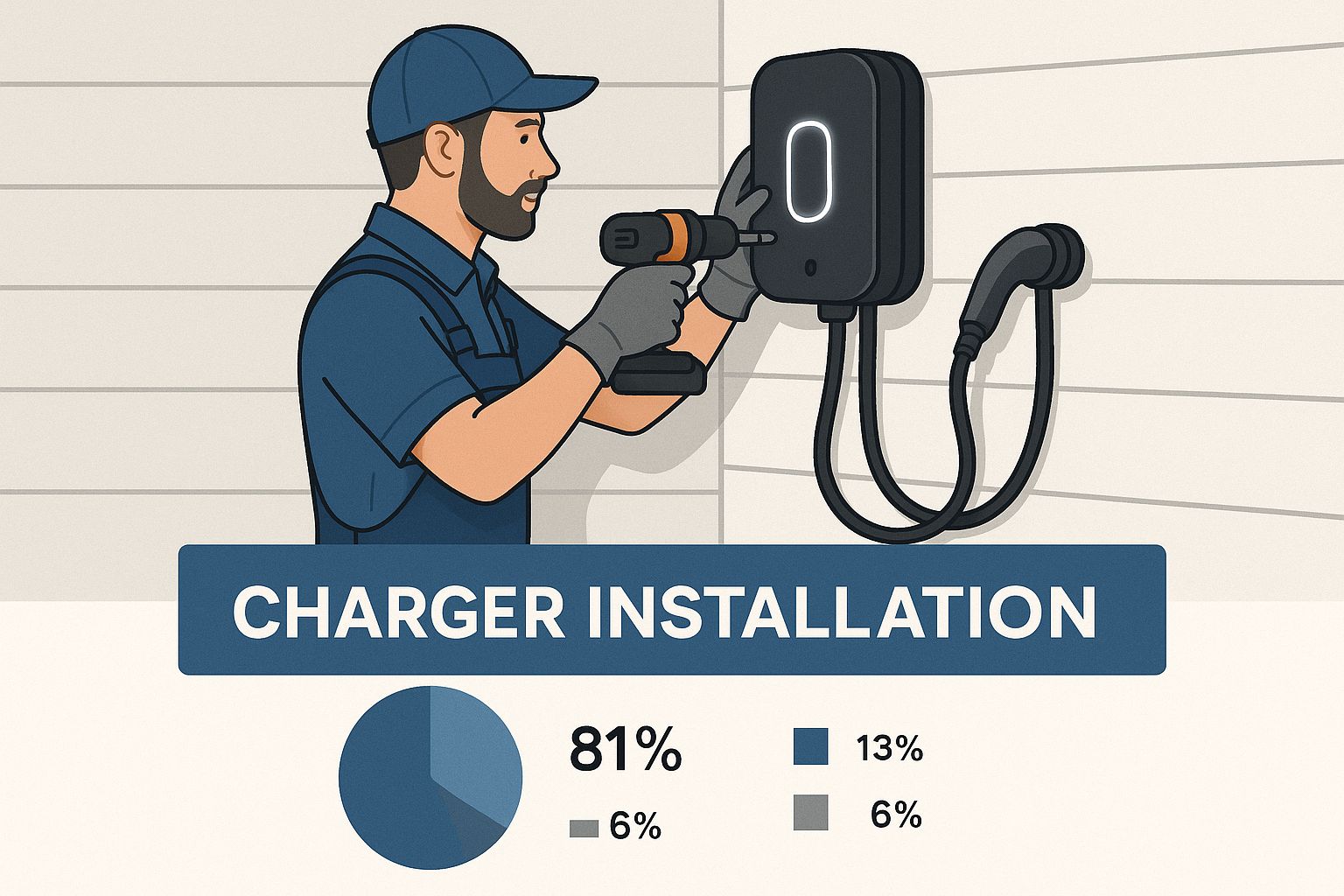
Getting a qualified electrician to handle the installation is non-negotiable. It is the only way to guarantee safety and get the best performance out of your new charging point.
UK Home EV Charger Comparison
To help you get a clearer picture, I have put together a quick comparison of the common charger types you will find in the UK. This should make it easier to see which one fits your needs and your home's electrical setup.
| Charger Type | Typical Power | Approx. Charging Time (60kWh Battery) | Installation | Best For |
|---|---|---|---|---|
| 3-Pin Plug ('Granny Charger') | 2.3kW | 24-26 hours | None | Emergency use or occasional top-ups only. |
| Dedicated Wallbox | 3.6kW | 16-18 hours | Professional electrician | Homes with older wiring or lower power supply. |
| Dedicated Wallbox | 7kW / 7.4kW | 8-9 hours | Professional electrician | The standard for most modern homes and EVs. |
| Three-Phase Wallbox | 22kW | 2-3 hours | Specialist electrician; requires three-phase supply | Homes with a three-phase connection; high-mileage drivers. |
| ZPN Rapid Home Charger | 50kW | 1-1.5 hours | Specialist electrician; requires single-phase supply | High mileage drivers, drivers who need convenience, first responders. |
As you can see, the jump from a 3-pin plug to a dedicated 7kW wallbox makes a world of difference for daily driving. It turns charging from a day-long or overnight task into a simple one hour routine.
Government Grants and Installation Costs
The UK government has been keen to encourage the switch to electric vehicles. For a long time, grants from the Office for Zero Emission Vehicles (OZEV) helped homeowners cover a chunk of the installation cost. While the grant scheme has changed over the years and is now more targeted (for example, at people in flats or rented properties), it is always worth checking the latest rules to see if you might be eligible. Any saving on the initial outlay is a bonus.
Investing in a dedicated smart charger is one of the smartest moves you can make as an EV owner. The ability to schedule your charging for those cheap, off-peak electricity rates means you are always paying the lowest possible price to run your car.
How to Profit from a Mobile Charging Business
While charging your EV at home is a game-changer for personal use, it has also opened up a whole new and surprisingly profitable business idea. The boom in electric vehicles has sparked a demand for a modern roadside assistance service: mobile EV charging. This is a business built on ultimate convenience. You are not just selling electricity from the back of a van; you are selling a premium, on-demand solution that provides peace of mind and saves drivers time. For an entrepreneur, this translates into a low-overhead, high-margin service model built for the electric age.
Identifying Your Target Market
You might think your only customer is the driver who has misjudged their range, but the demand for on-the-go power is much broader. This diverse customer base is waiting for a mobile charging solution.
Think about these key groups:
- Stranded Drivers: This is your bread and butter. A quick 10-15 kWh boost is usually more than enough to get them to the nearest public charger or safely back home. You are their roadside saviour.
- Residents in Flats: A huge portion of the UK population lives in flats or terraced houses with no off-street parking. Installing a home charger is simply not an option. A scheduled, weekly top-up service can be an absolute lifeline.
- Commercial Fleets: Delivery firms and taxi companies are switching their fleets to electric. Instead of them footing the bill for expensive grid upgrades at their depots, you can offer on-site charging that ensures their vehicles are ready for the next shift.
- Event and Destination Charging: Picture a food festival, a rural wedding venue, or a pop-up market. Offering temporary mobile charging can be a massive selling point for the organisers and a fantastic, reliable income stream for you.
By tapping into both emergency call-outs and scheduled contract work, you create a much more resilient business. You are not just waiting for the phone to ring; you are building a reliable, recurring revenue stream.
Calculating Your Potential Earnings
To make this work, you need a smart pricing structure that covers your costs—the van, the mobile charging unit, insurance, and the electricity itself—while leaving a healthy profit margin.
A simple and effective approach is to combine a fixed call-out fee with a variable rate for the energy delivered.
A typical pricing strategy involves a call-out fee of £30-£50 to cover your time and travel, plus a per-kilowatt-hour (kWh) rate. This rate needs to be higher than public chargers to reflect the premium convenience you offer, often around 85p to £1 per kWh .
Let’s run through a real-world scenario. A driver is stranded and needs a 15kWh top-up. Here is what your invoice might look like:
- Call-Out Fee: £40
- Electricity Charge: 15 kWh @ £0.90/kWh = £13.50
- Total Revenue: £53.50
If you can handle just four of these emergency calls a day, you are looking at a daily revenue of over £200 . Now, imagine layering a commercial contract on top of that. An agreement to charge five local delivery vans twice a week could easily add another £1,000-£1,500 to your monthly income. With low overheads and high demand, a well-run mobile charging business can generate over £50,000 a year in profit for a sole operator. The numbers are compelling; this is a serious business opportunity.
A Practical Guide to Safe and Efficient Charging
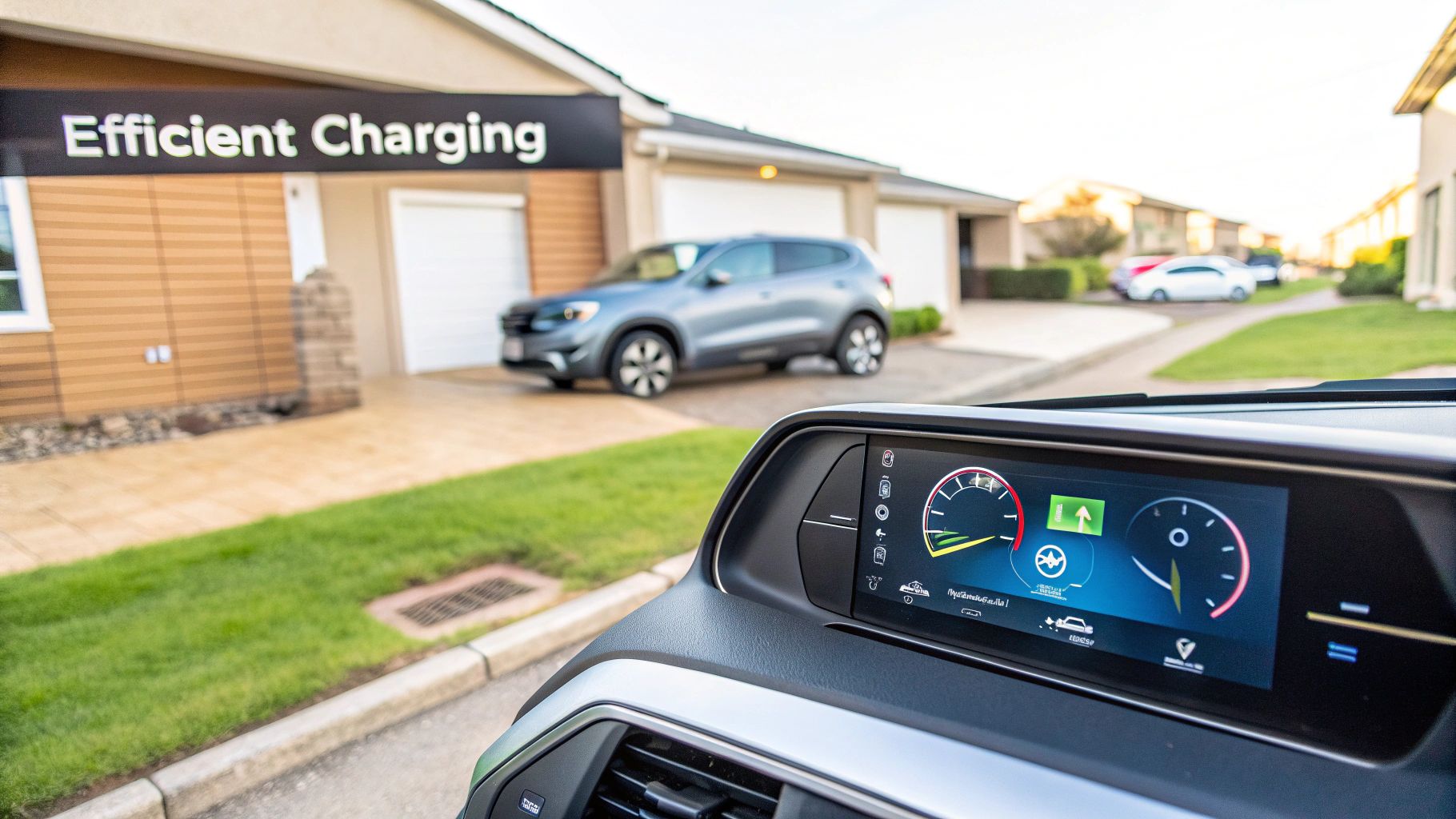
Think of your car's battery as a muscle. You would not push it to its absolute limit every single day without rest. A consistent, smart routine for charging your car battery at home will pay you back with better performance and longevity for years to come.
Your Daily Charging Checklist
Before you plug in each evening, get into the habit of doing a quick visual check. It only takes a few seconds and is your first line of defence against potential problems.
Make sure the charging cable is not frayed, kinked, or showing any signs of damage. Also, check that the port on your car and the charger's plug are clean and free from any dirt or moisture. When you connect the cable, it should click firmly into place. A loose connection can interrupt the charging session or, in rare cases, create a safety risk.
Maximising Battery Health and Minimising Costs
To really get the most out of your battery, try to avoid regularly charging it to 100% . Most manufacturers recommend setting a daily charging limit of around 80-90% for normal use. This simple step reduces stress on the battery cells, which helps preserve its capacity over the long term.
Smart chargers are brilliant for this. They let you use an app to set these limits and, more importantly, schedule your charging for off-peak hours when electricity is cheapest. This ensures you are not just looking after your battery but also your wallet.
While home charging is incredibly convenient, it is part of a much wider UK network. As of May 2025, the UK had 80,998 public charging devices, with rapid chargers making up about 60% of the public capacity. This growth is essential for long journeys but it really highlights how home charging remains the core, cost-effective solution for daily driving.
Monitoring the Process
Once your car is plugged in and charging, you do not need to stand over it. Modern EVs and smart chargers make monitoring a breeze. You can check the progress through your car's dashboard display or, more conveniently, via a smartphone app.
These apps typically show you:
- The current state of charge (SoC) as a percentage.
- The estimated time remaining until it reaches your set limit.
- The current charging speed in kilowatts (kW).
- The amount of energy delivered in kilowatt-hours (kWh).
This data is surprisingly useful. For instance, if you want to understand exactly what you are paying for each session, you can learn more about how to calculate a kilowatt-hour in our detailed guide. This knowledge empowers you to make smarter decisions about when and how you charge.
Troubleshooting Common Home Charging Issues
Even with the best EV charging setup, you might occasionally hit a snag. Think of this as your first-aid guide for those frustrating moments, helping you figure out what has gone wrong without having to immediately call in a professional.
Most home charging problems are surprisingly simple to fix. They usually boil down to a handful of common causes, from a tripped breaker to a simple communication glitch between your car and the charger. Let’s walk through the most frequent culprits and what you can do about them.
My Charger Won’t Start
This is easily the most common issue—and the most alarming—but the fix is usually straightforward. Before you panic, run through this quick mental checklist.
The first place to look is your home’s electricity supply.
- Check the Circuit Breaker: Your EV charger should be on its own dedicated circuit. Head to your consumer unit (or fuse box) and see if the breaker for the charger has tripped. If it has, just flick it back on. If it trips again right away, do not reset it again . This points to a more serious electrical fault that needs a qualified electrician.
- Inspect the Cable and Connections: Is the charging cable securely plugged into both the charger and your car? It sounds obvious, but a loose connection is often the culprit preventing a charging session from starting.
- Test Other Appliances: Has the power gone out in the whole house? A local power cut is a simple but often overlooked reason your charger is not working.
Sometimes, the problem is not with the power at all, but a communications breakdown between the car and the charger. Try a quick 'reboot'—unplug the car, lock and unlock it, and then plug the cable back in. This often re-establishes the connection and gets things moving again.
Charging is Slower Than Expected
Another frequent complaint is a charging speed that feels disappointingly sluggish. If your shiny new 7kW charger seems to be performing more like a 3kW unit, several things could be at play, and it does not always mean there is a fault.
It is amazing how much of an impact environmental and household factors can have.
Your EV is smarter than you think. In very cold weather, the battery management system will deliberately slow down the charging speed to protect the battery cells. This is perfectly normal and is designed to preserve the long-term health of your battery.
Other common reasons for slow charging include:
- Household Power Load: If other power-hungry appliances like an electric shower or oven are running, some smart chargers will automatically throttle back the power to your car. This is a safety feature designed to avoid overloading your home's main fuse.
- Vehicle Settings: It is worth diving into your vehicle’s charging settings. It is possible you have accidentally set a lower amperage limit or scheduled a charging session for a time that has not been reached yet.
- Charger Fault: In rare cases, an internal fault in the charger itself could limit its power output. If you have confidently ruled everything else out, it might be time to get in touch with the manufacturer's support line.
Answering Your Home Charging Questions
We get asked a lot about the nuts and bolts of charging an electric car at home. To cut through the noise, we have gathered the most common questions and answered them right here, giving you the clear, straightforward information you need.
How Much Does a Home Charger Installation Cost in the UK?
You can typically expect the cost to install a home EV charger in the UK to fall somewhere between £800 and £5,000 with rapid home chargers costing £3500. This figure usually covers both the charger unit itself and the standard installation by a qualified electrician.
Of course, the final bill can shift a bit depending on a few things. A more powerful charger (a 7kW unit is the go-to for most homes) or one with extra smart features might nudge the price up. The complexity of your home’s wiring also plays a part – a tricky installation means more labour time for the electrician. It is also worth checking for government grants, as tenants and flat owners may be eligible for schemes that can bring this initial cost down significantly.
While that upfront cost might seem steep, remember what you are getting. The long-term savings from dodging expensive public chargers often mean the unit pays for itself. Plus, the sheer convenience of waking up to a fully charged car every single morning? That is priceless.
Can I Just Use a Regular 3-Pin Plug to Charge My Car?
Technically, yes, you can use a standard 3-pin socket with a special cable (often called a 'granny charger'). But honestly, it is not a great long-term plan. This method is incredibly slow, delivering only around 2.3kW of power. For a modern EV battery, that could mean waiting well over 24 hours for a full charge.
More importantly, there is a safety concern. Using a 3-pin plug this way puts a huge, sustained strain on your home’s wiring, which simply was not designed for that kind of high load over many hours. For both safety and convenience, a dedicated, professionally installed charge point is always the best way to go.
How Would I Calculate Profit for a Mobile Charging Business?
To figure out your potential profit, you need to balance your costs against your income. On the cost side, you have the mobile charging unit (which includes the van and battery system), insurance, fuel or charging for your own vehicle, and marketing.
Your revenue can be structured in a few different ways, but a popular model is to charge a call-out fee (say, £30-£50 ) plus a per-kWh rate that is a bit higher than what you would find at a public charger (for example, 85p-£1 per kWh ).
Let's walk through a quick example:
- The Scenario: A driver is stranded and needs a quick 10kWh top-up to get to the next charger.
- Your Call-Out Fee: You charge £50 .
- Your Electricity Fee: At £1 per kWh , that is another £10 .
- Total Revenue: From that single job, you have just generated £60 .
This kind of business provides a genuinely vital service to EV drivers in a pinch and has the potential to be very profitable. You could even build a more stable income stream by offering subscription services to local businesses that run their own fleets of electric vehicles.
For pioneering mobile and portable EV charging solutions that can get your own mobile charging business started, trust ZAPME . Explore our range of services at https://www.zapme.biz.

